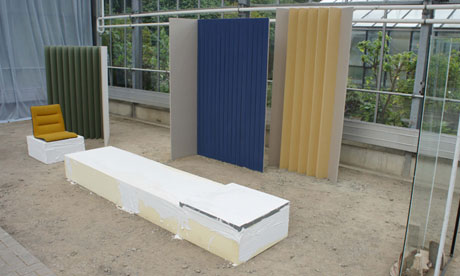(guardian.co.uk- By Skye Sherwin) This Georgia-born artist works quickly and intuitively, creating poetic, allusive arrangements that hint at ever-shifting stories.
 |
| A greenhouse emptied of plant life provides the perfect setting for Thea Djordjadze's As sagas sa. Photograph: David Meskhi ©/courtesy Sprüth Magers Berlin London |
It's rare that art as apparently spartan as Thea Djordjadze's can be so tantalising. The thin wooden or metal frames and glass vitrines that frequently star in her sculptural assemblages suggest a minimalist sensibility and evoke the pristine, poker-faced displays of museums. Yet these elements of her art rub shoulders with more worn-in, personal fare, including rugs, reconfigured furniture and rough, hand-moulded lumps of uncooked clay. Things look fragile and faded, like relics from a lost civilisation.
Djordjadze's materials are worked fast and arranged intuitively, with an eye for colour, texture and lines drawn through space that hints at her early training as a painter. Growing up in former communist Georgia has also left its mark on the Berlin-based artist's sensibility. Her work often features the country's local carpets, while its pared-back appearance and flimsy materials echo the clean, definite forms of eastern-bloc architecture, belying a shaky political regime. In place of modernist purity, she creates poetic, allusive arrangements of objects, hinting at stories that never sit still.
As sagas sa, her contribution to the current Documenta (13), uses the perfect setting for her sculptural micro-universe: a cavernous greenhouse emptied of plant life, with a gravelly dry-dirt floor and stained panes. It's like a cross between some millennia-old museum's vitrine and a wasted version of the vegetation-filled glass domes travelling through space, in the 1970s sci-fi classic Silent Running.
Wandering through the installation she's created in response to the site, you're in a self-contained world. Tableaux of furniture, glass cases and paint-smeared blocks of foam suggest the enclosed realms of both domestic life and theatrical display. A faded, cheap, gauzy fabric hangs across one end of the arid greenhouse like a stage curtain, or a waterfall.
All these objects soon start to shapeshift in your head. A sharp rectangle and square become a neatly geometric bed and pillow. Yet for all its minimalist precision, the piece is made of squidgy, vulnerable foam and smeared with gooey white pigment. It's unnervingly physical, begrimed, sexual. The plastic chair sitting at its foot might be a nurse at a sickbed, or the aggressive master to this passive, prone form.
With dust underfoot and in your lungs, it's like being in an ancient burial chamber, and yet those urgent white plaster smears are very much in the present tense. There's the electric sensation that all is held in suspense, while perpetually shifting between one state and another.
Why we like her: For Deaf and Dumb Universe, which echoed the chic glass and steel architecture of Berlin's Neue Nationalgalerie, with blocky foam chairs tottering on black spidery legs, lumpy bits of clay perched on clean white shelving, and a metal frame shaped like a wendy house.
Two Heads: Beyond her solo projects, Djordjadze has long collaborated with her friend and former teacher, feminist art icon Rosemarie Trockel
Where can I see her? At Documenta (13) in Kassel, Germany, until 16 September, and Sprueth Magers, London, until 29 September.











No comments:
Post a Comment